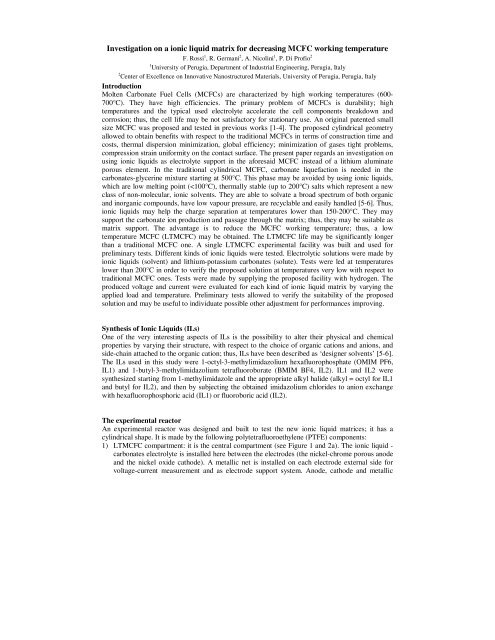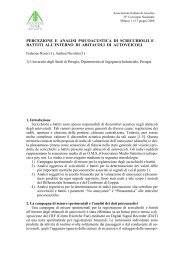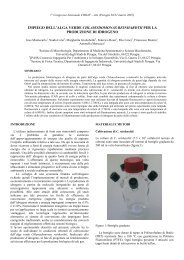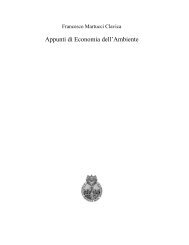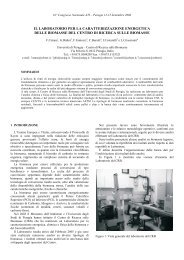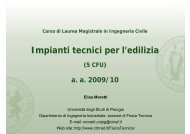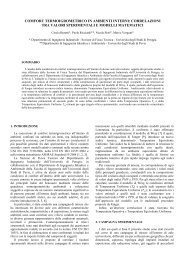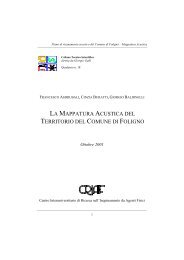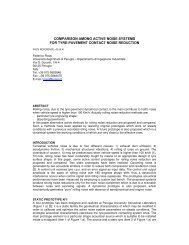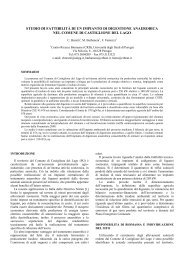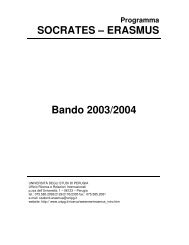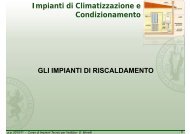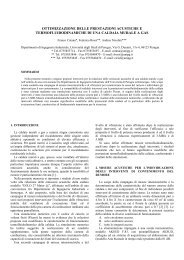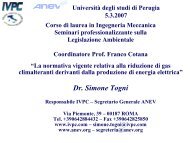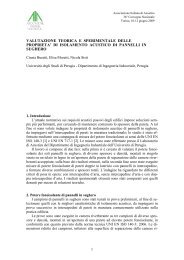Investigation on a ionic liquid matrix for decreasing MCFC ... - CIRIAF
Investigation on a ionic liquid matrix for decreasing MCFC ... - CIRIAF
Investigation on a ionic liquid matrix for decreasing MCFC ... - CIRIAF
You also want an ePaper? Increase the reach of your titles
YUMPU automatically turns print PDFs into web optimized ePapers that Google loves.
nets are supported by a holed PTFE wall in the supplied gases side. The holed PTFE wallallows the gas tight and supplying.2) Anodic gases compartment (see Figure 1): it is c<strong>on</strong>nected to the anodic gases distributi<strong>on</strong>system by copper pipes in the lateral side. Hydrogen and nitrogen are supplied to the anode bythe holed PTFE wall;3) Cathodic gases compartment (see Figure 1): it is c<strong>on</strong>nected to the cathodic gases distributi<strong>on</strong>system by copper pipes in the lateral side. Air, carb<strong>on</strong>ic dioxide and nitrogen are supplied to thecathode by the holed PTFE wall.4) a plug which closes the reactor. The plug is characterized by (see Figure 2b):- anodic and cathodic outlets over the electrode compartments;- a central hole <strong>for</strong> the installati<strong>on</strong> of a thermocouple <strong>for</strong> electrolyte temperaturemeasurements;- four holes (two <strong>for</strong> each electrode net) <strong>for</strong> voltage and current measurements by copperleads;- a plugged hole <strong>for</strong> electrolyte soluti<strong>on</strong> restoring over the electrolyte compartment;- two groovings in the plug bottom side <strong>for</strong> electrodes and metallic nets casing.LT<strong>MCFC</strong> COMPARTMENTANODIC GASESCOMPARTMENTCATHODIC GASESCOMPARTMENTFigure 1 – the experimental reactor (upside view)ELECTRODESa)HOLED PTFEWALLFigure 2 – (a) the experimental reactor (perspective view); b) the reactor plugb)
A pressurizati<strong>on</strong> system allows keeping the gases compartments at a pressure 50mbar higher thanthe LT<strong>MCFC</strong> <strong>on</strong>e; this adjustment increases the electrolyte soluti<strong>on</strong> tight. The experimental facilityis made by the reactor, a gas supplying system and a heating system. The heating system is madeby a thermostatic bath c<strong>on</strong>stituted by silic<strong>on</strong> oil in a steel box. An electromagnetic agitator andheater allows the bath uni<strong>for</strong>m heating. Besides, the facility was thermally insulated during the testsin order to minimize the thermal dispersi<strong>on</strong>s. The facility is shown in Figure 3.Figure 3 – the experimental facilityThe experimental testsExperimental tests were made by the facility with different electrolyte soluti<strong>on</strong>s c<strong>on</strong>stituted byi<strong>on</strong>ic <strong>liquid</strong>s and carb<strong>on</strong>ates. Two kinds of i<strong>on</strong>ic <strong>liquid</strong>s were tested (identified by IL1 and IL2codes). Their characteristics in terms of kinematic viscosity (measured by Ubbelohde viscosimeterssoaked into thermostatic baths) and electrical c<strong>on</strong>ductivity (measured by a c<strong>on</strong>ductivimeter) areshown in Table 1. The tested electrolyte soluti<strong>on</strong>s were made by the i<strong>on</strong>ic <strong>liquid</strong>s (solvent) andcarb<strong>on</strong>ates (solute) 5% or 9.7% by weight. It was verified that carb<strong>on</strong>ates mixing does not modifythe electrical c<strong>on</strong>ductivity of the i<strong>on</strong>ic <strong>liquid</strong>s.Table 1: the tested i<strong>on</strong>ic <strong>liquid</strong>s characteristicsKinematic viscosity at 25°C Electrical c<strong>on</strong>ductivity at 25°CI<strong>on</strong>ic <strong>liquid</strong>(m 2 /s)(S/m)IL1 3.46*10 -4 0,02IL2 3.87*10 -5 0,12Tests were made <strong>for</strong> three LT<strong>MCFC</strong> temperatures: 50, 100 and 150 °C. Open-circuit voltages weremeasured and electrical loads were applied to measure the electrical current <strong>on</strong> a closed circuit. Forbrevity, Table 2 reports <strong>on</strong>ly open-circuit voltages, 1.5 ohm load voltages and 1.5 ohm loadcurrents. Results shows that <strong>on</strong>ly IL1 allows the LT<strong>MCFC</strong> working. IL2 applicati<strong>on</strong> does not
produce voltage and obviously current. Gascromatographic analyses were made <strong>on</strong> inlet and outletgases relatively to IL1 tests; results verified that the reacti<strong>on</strong> occurs correctly both <strong>for</strong> cathodic andanodic compartment.Table 2: experimental tests results (IL1-based electrolyte)ElectrolyteTemperature(°C)Open-circuitvoltage(V)Voltage produced Current producedwhen a 1.5 ohm load when a 1.5 ohm loadis applied is applied(V)(mA)50 0.062 0.010 0.030100 0.037 0.010 0.042weight) 150 0.032 0.020 0.06050 0.068 0.010 0.021100 0.038 0.013 0.041weight) 150 0.034 0.022 0.351IL1+carb<strong>on</strong>ates soluti<strong>on</strong>(carb<strong>on</strong>ate 5% byIL1+carb<strong>on</strong>ates soluti<strong>on</strong>(carb<strong>on</strong>ate 9.7% byIn particular, IL1-carb<strong>on</strong>ates soluti<strong>on</strong> works as good electrolyte when the carb<strong>on</strong>ate percentage isabout 10% by weight at 150°C. Otherwise, very low current is measured (also <strong>for</strong> different appliedelectrical load) <strong>for</strong> lower temperatures or lower carb<strong>on</strong>ates percentage. Thus, the reportedpreliminary tests allows to define the proposed <strong>matrix</strong> as possible soluti<strong>on</strong> <strong>for</strong> <strong>decreasing</strong> <strong>MCFC</strong>working temperature.C<strong>on</strong>clusi<strong>on</strong>sPreliminary experimental tests were carried out to verify the suitability of the proposed i<strong>on</strong>ic <strong>liquid</strong>basednew <strong>matrix</strong> <strong>for</strong> cylindrical <strong>MCFC</strong>s. An experimental facility was built c<strong>on</strong>stituted by areactor, a heating system and a gas distributi<strong>on</strong> system. Two kinds of i<strong>on</strong>ic <strong>liquid</strong>s were tested assupport <strong>for</strong> <strong>matrix</strong> realizati<strong>on</strong>. Tests were carried out <strong>for</strong> temperatures up to 150°C. Results showedthat IL1 i<strong>on</strong>ic <strong>liquid</strong> may be a good soluti<strong>on</strong> <strong>for</strong> <strong>decreasing</strong> <strong>MCFC</strong> temperature and increasing<strong>MCFC</strong> life. <str<strong>on</strong>g>Investigati<strong>on</strong></str<strong>on</strong>g>s are going <strong>on</strong> to individuate soluti<strong>on</strong>s and adjustments <strong>for</strong> testing theproposed <strong>matrix</strong> <strong>on</strong> the cylindrical single <strong>MCFC</strong> or stack [1-4]. The optimized soluti<strong>on</strong> may help tobuild low temperature <strong>MCFC</strong> (LT<strong>MCFC</strong>) limiting comp<strong>on</strong>ents corrosi<strong>on</strong> and breakdown problems.References[1] IPASS, “Dispositivo Termoelettrochimico a Carb<strong>on</strong>ati Fusi per la Generazi<strong>on</strong>e C<strong>on</strong>temporaneadi Elettricità e Calore a Geometria Cilindrica”, Ministero dell’Industria, del Commercio edell’Artigianato, Patent N. PG2003A0019, Italy, 2003.[2] F.Rossi, U.Di Matteo, A.Nicolini, “New soluti<strong>on</strong>s and materials <strong>for</strong> Molten Carb<strong>on</strong>ate FuelCells”, Fuel Cell Seminar 2004, San Ant<strong>on</strong>io, USA, 1-5 November 2004.[3] F.Rossi, U. Di Matteo, A.Nicolini, M. Filipp<strong>on</strong>i, “Per<strong>for</strong>mances of a New Cylindrical MoltenCarb<strong>on</strong>ate Single Cell”, Fuel Cell Seminar 2005, Palm Springs, USA, 14-18 November 2005.[4] F. Rossi, U. Di Matteo, A. Nicolini, “A 1kW Cylindrical Molten Carb<strong>on</strong>ate Fuel Cell”, FuelCell Seminar 2006, H<strong>on</strong>olulu, USA, 13-17 November 2006.[5] L. Brinchi, R. Germani, G. Savelli, "I<strong>on</strong>ic <strong>liquid</strong>s as reacti<strong>on</strong> media <strong>for</strong> esterificati<strong>on</strong> ofcarboxylate sodium salts with alkyl halides", Tetrahedr<strong>on</strong> Letters 44 (2003) 2027–2029.[6] L. Brinchi, R. Germani, G. Savelli, "Efficient esterificati<strong>on</strong> of carboxylic acids with alkylhalides catalyzed by fluoride i<strong>on</strong>s in i<strong>on</strong>ic <strong>liquid</strong>s", Tetrahedr<strong>on</strong> Letters 44 (2003) 6583–6585.


